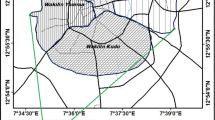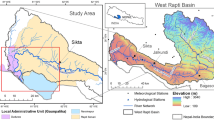Abstract
This work attempts to present the complex human–flood interactions from the chronically flood-affected district of Dhemaji in the Upper Brahmaputra floodplain. The objectives are to analyse perceptions, susceptibilities, indigenous knowledge and adaptations that enable coexistence of floods with floodplain dwellers. In addition, data on flood damage, breaches and cuts to embankments are collected from government departments and analysed. Results revealed a realistic perception of flood hazard amongst the floodplain dwellers. Susceptibility is higher due to the lack of infrastructure. Indigenous knowledge and adaptation strategies exist in the area enabling the floodplain dwellers to live with floods. The results also underscore the paradoxical situation where flood-control measures themselves have become detrimental to the floodplain dwellers. This creates a situation where environmental challenges outstrip the evolution of indigenous adaptation strategies. Our work is based in the Upper Brahmaputra River plains and is a contribution towards the long-standing debate on the choices humans make in response to riverine hazards.



Similar content being viewed by others
References
Adelekan IO (2011) Vulnerability assessment of an urban flood in Nigeria: Abeokuta flood 2007. Nat Hazards 56:215–231
Baan PJA, Klijn F (2004) Flood risk perception and implications for flood risk management in the Netherlands. Int J River Basin Manag 2:113–122
Bielders CL, Ramelot C, Persoons E (2003) Farmer perception of runoff and erosion and extent of flooding in the silt-loam belt of the Belgian Walloon region. Environ Sci Policy 6:85–93
Brammer H (1990) Floods in Bangladesh I: geographical background to the 1987 and 1988 floods. Geogr J 156:12–22
Brilly M, Polic M (2005) Public perception of flood risks, flood forecasting and mitigation. Nat Hazards Earth Syst Sci 3:345–355
Burton I, Kates RW, White GF (1968) The human ecology of extreme geophysical events. Natural Hazards, working paper no. 1
Cutter SL (1996) Vulnerability to environmental hazards. Prog Hum Geogr 20:529–539
Das B (2011) Stakeholders’ perception in identification of river bank erosion hazard: a case study. Nat Hazards 58:905–928
Das AK, Sah RK, Hazarika N (2012) Bankline change and the facets of riverine hazards in the floodplain of Subansiri-Ranganadi Doab, Brahmaputra Valley, India. Nat Hazards 64:1015–1028
Davis I (2004) Progress in analysis of social vulnerability and capacity. In: Bankoff G, Freks G, Hilhorst D (eds) Mapping vulnerability: disasters, development and people. Earthscan, London, pp 128–144
Goswami DC (1998) Fluvial regime and flood hydrology of the Brahmaputra River, Assam. In: Kale VS (eds) Flood studies in India. Geological Society of India, Memoir 41, Bangalore, India, pp 53–75
Hiwasaki L, Luna E, Syamsidik Shaw R (2014) Process for integrating local and indigenous knowledge with science for hydro-meteorological disaster risk reduction and climate change adaptation in coastal and small island communities. Int J Disaster Risk Reduct 10:15–27
Ignatowski JA, Rosales J (2013) Identifying the exposure of two subsistence villages in Alaska to climate change using traditional ecological knowledge. Clim Change 121:285–299
Jabeen H, Johnson C, Allen A (2010) Built-in resilience: learning from grassroots coping strategies for climate variability. Environ Urbanization 22:415–431
Krasovskaia I, Gottschalk L, Sælthun NR, Berg H (2001) Perception of the risk of flooding: the case of the 1995 flood in Norway. Hydrol Sci J 46:855–868
Lin S, Shaw D, Ho M-C (2008) Why are flood and landslide victims less willing to take mitigation measures than the public? Nat Hazards 44:305–314
Löfstedt RE (1995) Why are public perception studies on the environment ignored? Glob Environ Change 5(2):83–84
López-Marrero T (2010) An integrative approach to study and promote natural hazards adaptive capacity: a case study of two flood-prone communities in Puerto Rico. Geogr J 176:150–163
Ludy J, Kondolf GM (2012) Flood risk perception in lands “protected” by 100-year levees. Nat Hazards 61:829–842
McNie EC (2007) Reconciling the supply of scientific information with user demands: an analysis of the problem and review of the literature. Environ Sci Policy 10:17–38
Mercer J, Kelman I, Dekens J (2009) Integrating indigenous and scientific knowledge for disaster risk reduction. In: Shaw R, Sharma A, Takeuchi I (eds) Indigenous knowledge and disaster risk reduction. Nova Science Publishers, Hauppauge, pp 115–131
Mercer J, Kelman I, Taranis L, Suchet-Pearson S (2010) Framework for integrating indigenous and scientific knowledge for disaster risk reduction. Disasters 34:214–239
Mitchell JK (1989) Hazards Research. In: Gaile GL, Willmott CJ (eds) Geography in America. Merrill, Columbus, pp 410–424
Motoyoshi T (2006) Public perception of flood risk and community-based disaster preparedness. In: Ikeda S, Fukuzono T, Sato T (eds) A better integrated management of disaster risks: toward resilient society to emerging disaster risks in mega-cities. TERRAPUB and NIED, Tokyo, pp 121–134
Ologunorisa TE, Adeyemo A (2005) Public perception of flood hazard in the Niger Delta, Nigeria. Environmentalist 25:39–45
Pearce L (2003) Disaster management and community planning, and public participation: How to achieve sustainable hazard mitigation. Nat Hazards 28:211–228
Planning Commission, Government of India, (Annual Reports from 2001–2013) http://planningcommission.gov.in/reports/genrep/annrep.php?repts=b_annrep.htm. Last accessed on 02 Feb 2015
Saarinen TF (1969) Perception of the environment. Commission on College Geography Resource paper no. 5. Association of American Geographers, Washington, DC
Siegrist M, Gutscher H (2006) Flooding risks: a comparison of Lay people’s perception and Expert’s assessment in Switzerland. Risk Anal 26:971–979
Slovic P, Kunreuther H, White GF (1974) Decision processes, rationality and adjustment to natural hazards. In: White GF (ed) Natural hazards, local, national, and global. Oxford University Press, New York, pp 187–205
Speranza CL, Kiteme B, Ambenje P, Wiesmann U, Makali S (2010) Indigenous knowledge related to climate variability and change: insights from droughts in semi-arid areas of former Makueni District, Kenya. Clim Change 100:295–315
Tapsell SM, Penning-Rowsell EC, Tunstall SM, Wilson TL (2002) Vulnerability to flooding: health and social dimensions. Philos Trans R Soc A 360:1511–1525
Thieken AH, Kreibich H, Müüller M, Merz B (2007) Coping with floods: preparedness, response and recovery of flood-affected residents in Germany in 2002. Hydrol Sci J 52:1016–1037
Tran P, Marincioni F, Shaw R, Sarti M, An L (2008) Flood risk management in Central Viet Nam: challenges and potentials. Nat Hazards 46:119–138
UNESCO-IHE http://unescoihefvi.free.fr/flood_vulnerability_factors.php. Last accessed on 02 Feb 2015
Wamsler C (2007) Bridging the gaps: stakeholder-based strategies for risk reduction and financing for the urban poor. Environ Urban 19:115–142
Whitmarsh L (2008) Are flood victims more concerned about climate change than other people? The role of direct experience in risk perception and behavioural response. J Risk Res 11:351–374
WHO, flooding and communicable diseases fact sheet http://www.who.int/hac/techguidance/ems/flood_cds/en/. Last accessed on 02 Feb 2015
Williams T, Hardison P (2013) Culture, law, risk and governance: contexts of traditional knowledge in climate change adaptation. Clim Change 120:531–544
Wood LJ (1970) Perception studies in geography. Trans Inst Br Geogr 50:129–142
Acknowledgments
The authors are grateful to all the respondents for their active participation during the survey. We also thank all the government officials including late (Mr) U.K. Baruah, then A.D.C relief, late (Mr) Joydeep Choudhury and then Project Officer of SDMA, Dhemaji, for their help and cooperation during the field survey. We thank the Chief Engineer and Field Engineers of E&D department, Dhemaji district, for sharing flood damage data. We acknowledge the help received from Dr. Gitamani Dutta for the statistical analysis and Dr. Gaurangi Maitra for her comments on the manuscript and English language corrections. The authors would also like to thank Ms. Linda Fieldhouse for editing the manuscript for usage of English language and the anonymous reviewers whose comments helped to improve the manuscript to its present form. The first and the last authors acknowledge UGC for the fellowship provided to them for pursuing Ph.D.
Author information
Authors and Affiliations
Corresponding author
Electronic supplementary material
Below is the link to the electronic supplementary material.
Rights and permissions
About this article
Cite this article
Hazarika, N., Tayeng, T. & Das, A.K. Living in troubled waters: stakeholders’ perception, susceptibility and adaptations to flooding in the Upper Brahmaputra plain. Nat Hazards 83, 1157–1176 (2016). https://doi.org/10.1007/s11069-016-2366-1
Received:
Accepted:
Published:
Issue Date:
DOI: https://doi.org/10.1007/s11069-016-2366-1




